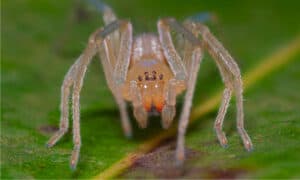10 Birds That Are Red
Birds come in a wide variety of colors. Some feature relatively dull plumage, while others sport brightly colored feathers. Birds with bright feathers usually evolved specific colors in order to help them attract mates. Depending on the environment where they live, a bird’s coloration can also help camouflage them from predators. In addition, many birds get their color from foods in their diet. Of those birds that feature colorful plumage, there exists a number of birds that are red. These fiery birds stand out from even other eye-catching birds due to their strong, red colors. You can find red birds all over the world, although many fall into the songbird family of smaller birds. That said, some also classify as parrots or wading birds. In this article, we’ll discuss 10 different birds that are red. Hopefully, the next time you’re out and about, you’ll see one of these crimson-colored birds.
#10: Crimson Sunbird
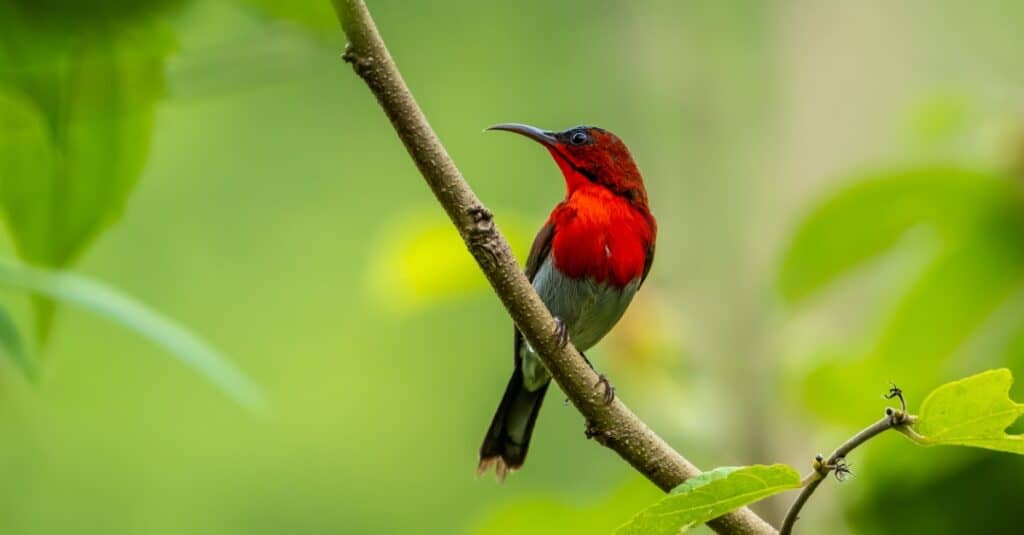
iStock.com/chirawan
A member of the sunbird family Nectariniidae, the crimson sunbird totally deserves its name. Males of these species feature a bright crimson breast and back. Meanwhile, their belly appears light green and their tail is a burnt yellow color. Crimson sunbirds range throughout South and Southeast Asia and prefer to live in tropical forests. These tiny 4-inch long birds that are red build suspended nests on tree branches to house their eggs. Sunbirds primarily live off of nectar that they gather from flowers, and the crimson sunbird is no different. A fast flyer, the crimson sunbird often gets mistaken for a hummingbird due to its hovering abilities. In addition, it also eats a wide variety of insects. On occasion, sunbirds also go by the name spiderhunters due to their habit of hunting spiders. Due to its widespread distribution, the IUCN lists the crimson sunbird as a species of Least Concern.
#9: Scarlet Ibis
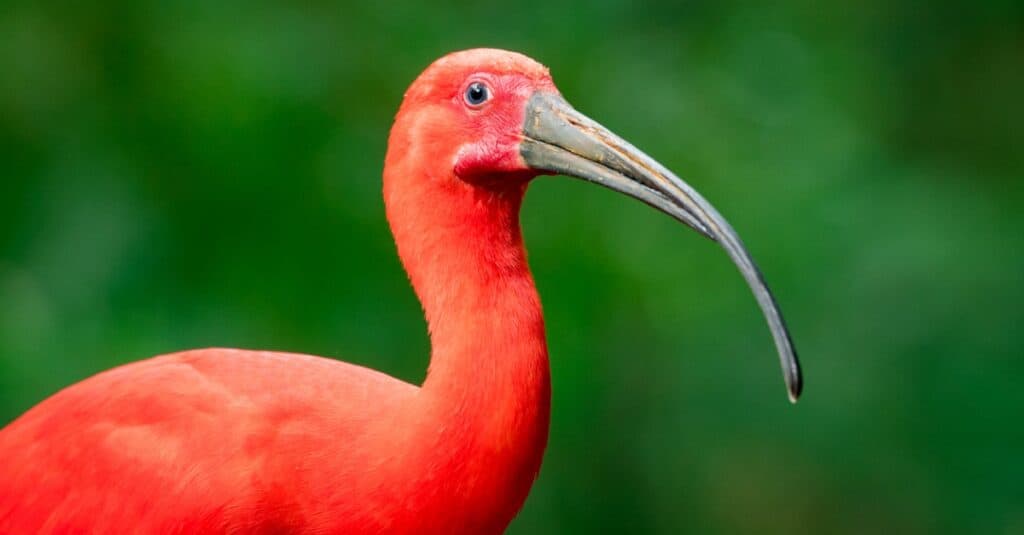
iStock.com/dabldy
The scarlet ibis is a member of the ibis family of birds Threskiornithidae. It stands apart from other ibises thanks to its bright scarlet coloration, which is where it gets its name. Virtually every part of its body is scarlet, from its head all the way to its toes. That said, their color includes a number of different shades that can range from light to dark. To find food, they use their long curved bills to dig in the mud, although they will also steal food from other animals. They get their red color from their diet of crab, shrimp, and other red shellfish. Scarlet ibises range throughout South America and the Caribbean and primarily live in wetland and coastal areas. Even outside of the breeding season, scarlet ibises live in large social groups. Currently, the IUCN lists the scarlet ibis as a species of Least Concern.
#8: Summer Tanager
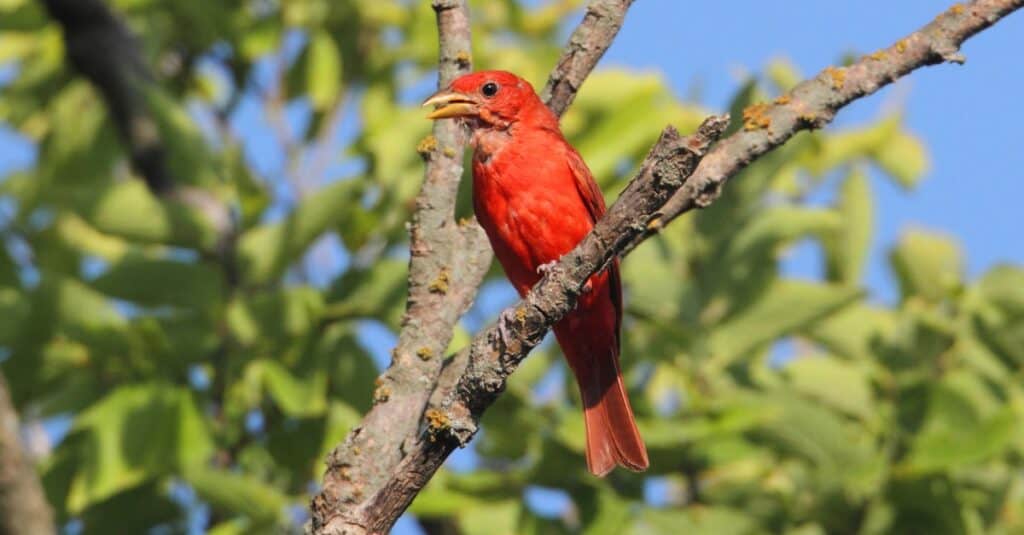
Despite its name, the summer tanager is a songbird in the cardinal family Cardinalidae. Its name comes from its bright red color that covers its entire body and evokes associations of warm summer days. Although their color varies, male summer tanagers usually grow rose-red feathers, while the females appear yellowish-green. Their red color comes from their diet, which consists of a variety of berries and insects, especially bees. They range throughout the southern United States and Mexico in the summer and Central and South America in the winter. Typically, they live in woodland areas with plenty of trees where they can build their nests. Summer tanagers measure around 6.7 inches long and weigh about 1 ounce. If you encounter one outdoors, you may find that its vocalizations sound similar to an American robin’s. At this time, the IUCN lists the summer tanager as a species of Least Concern.
#7: Red-Billed Firefinch
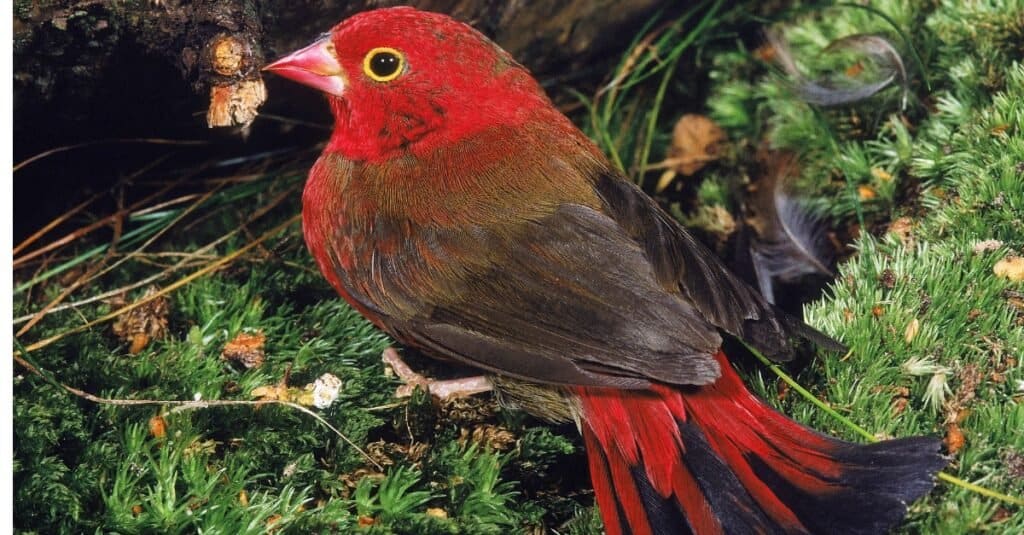
Also known as the Senegal firefinch, the red-billed firefinch is another one of the birds that are red. The males feature dull scarlet feathers, although their wings appear more rufous or brown than red. Meanwhile, females appear more brown than red but do feature a red patch of feathers on their faces. However, both males and females feature a pink bill and yellow rings around their eyes. Red-billed firefinches belong to the Estrildidae family of finches and are endemic to Sub-Saharan Africa. They live in grasslands as well as cultivated areas and often live in close proximity to humans. Their diet primarily consists of seeds, but they will also dine on certain locally grown grains. Red-billed firefinches build a unique domed nest made of grasses in which they lay their eggs. Given their massive range and numbers, the IUCN lists them as a species of Least Concern.
#6: Scarlet Tanager

Stubblefield Photography/Shutterstock.com
The scarlet tanager is another member of the Cardinalidae family, the same as the summer tanager. It gets its name from the distinctive crimson or scarlet coloring that the males feature during the summer. While males appear predominantly red, their wing and tail feathers look black. On the other hand, the females appear yellowish-green year-round. Generally, scarlet tanagers measure 6.3 to 7.5 inches long and weigh around 1 ounce. They range throughout the eastern United States, Canada, and Mexico, and spend the winter in South America. Unlike other cardinals, the scarlet tanager sports a rather thin bill. This means it eats fewer seeds than other cardinals, preferring instead to hunt insects. They can catch insects in flight or on the ground, and eat a wide variety including bees, wasps, and spiders. For now, the IUCN lists the scarlet tanager as a species of Least Concern.
#5: Red Crossbill
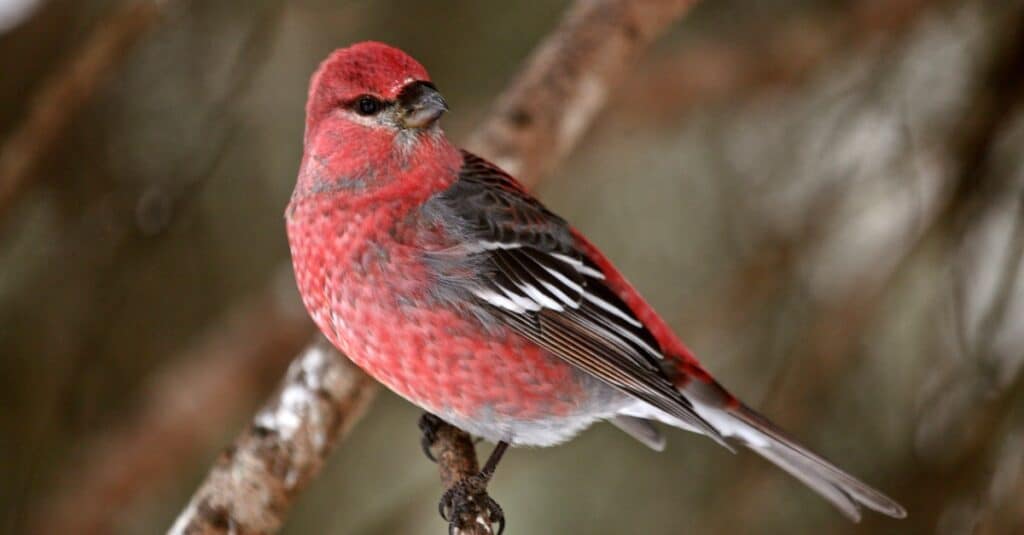
iStock.com/bobloblaw
The red crossbill or common crossbill is a member of the finch family Fringillidae. Males feature either bright red or orange feathers, while females typically appear yellow or green. That said, they can alter considerably in the wild and contain an assortment of colors in their plumage. In addition, their wings appear more dark brown compared to the rest of their plumage. Meanwhile, the other half of its name, crossbill, refers to the shape of its beak. The red crossbill sports a bill where the top half overlaps the bottom half. This overlapping design allows the red crossbill to subsist on a diet of mostly hard conifer seeds and other fruits. Red crossbills primarily live in coniferous forests throughout North America, Europe, and Asia. Given its abundance and widespread distribution, the IUCN lists the red crossbill as a species of Least Concern.
#4: Vermilion Flycatcher
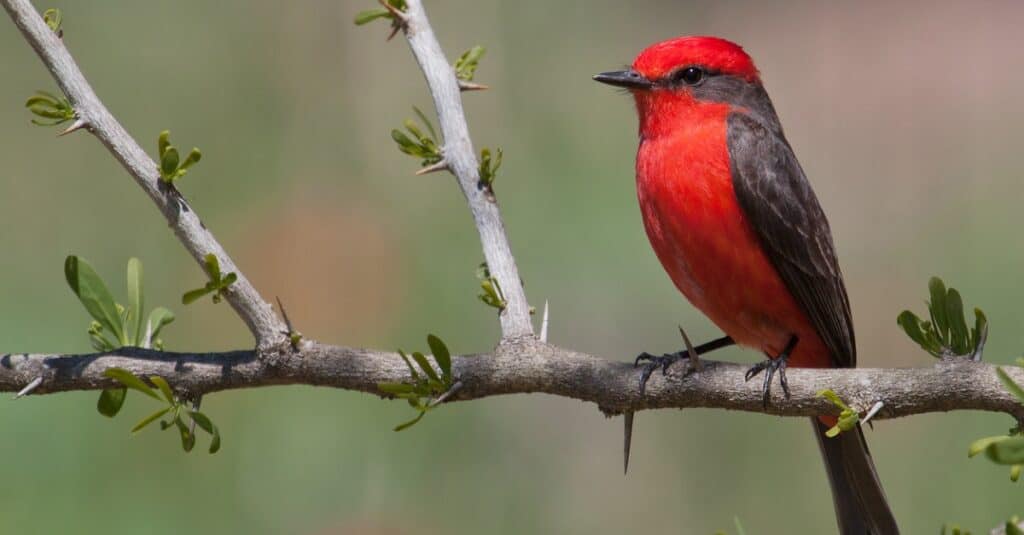
iStock.com/jsdeoliv
The vermilion flycatcher is a striking example among birds that are red. This tiny bird is a member of the tyrant flycatcher family Tyrannidae. The first half of its name, vermilion, refers to the bright vermillion-red color on the breast, belly, and crest of the males. Meanwhile, the second half of its name alludes to its habit of catching flies in midair. Aside from their red plumage, male vermilion flycatchers also feature brown tail and wing feathers. Most vermilion flycatchers measure between 5.1 to 5.5 inches long and weigh less than 0.5 ounces. They range throughout the southern United States, Mexico, and parts of South America. In addition to insects, their diet also includes a number of different grains. With a total population numbering in the millions, the IUCN lists the vermillion flycatcher as a species of Least Concern.
#3: Red-and-Green Macaw
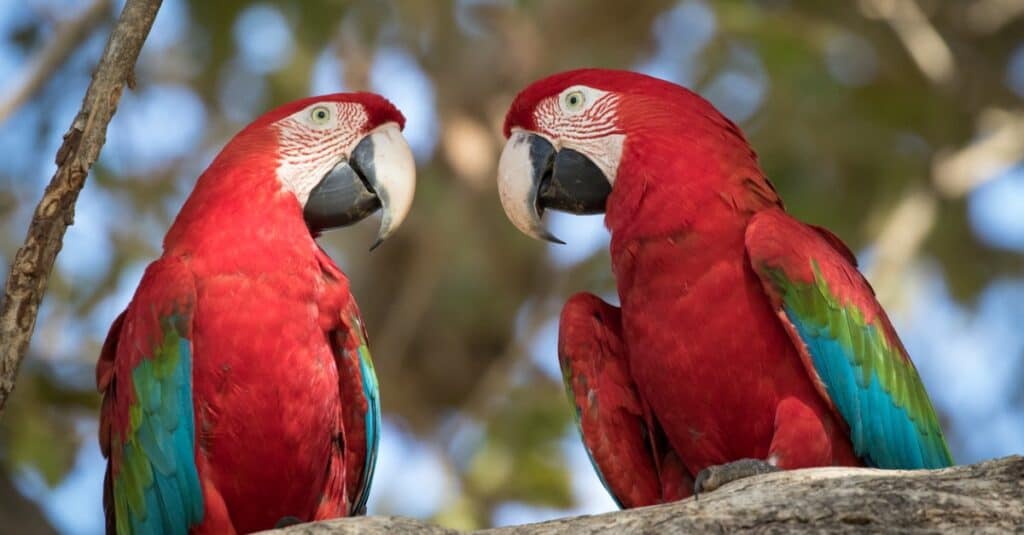
Also known as the green-winged macaw, the red-and-green macaw is a large parrot in the family Psittaciformes. The red-and-green macaw gets its name from its plumage. Its chest, head, shoulders, and parts of its tail feathers all appear bright red. Meanwhile, it also features green and blue feathers on its wings. Red-and-green macaws range between 35 to 37 inches long and weigh from 2.3 to 3.7 pounds. Due to their distinctive appearance, they rank as one of the most recognizable birds that are red. You can find them in the wild throughout their native range in Brazil, Colombia, Bolivia, Ecuador, Peru, and Paraguay. Due to habitat loss and illegal trafficking activity, the wild population of red-and-green macaws is in decline. That said, given its abundance, the IUCN still lists the red-and-green macaw as a species of Least Concern.
#2: Northern Cardinal
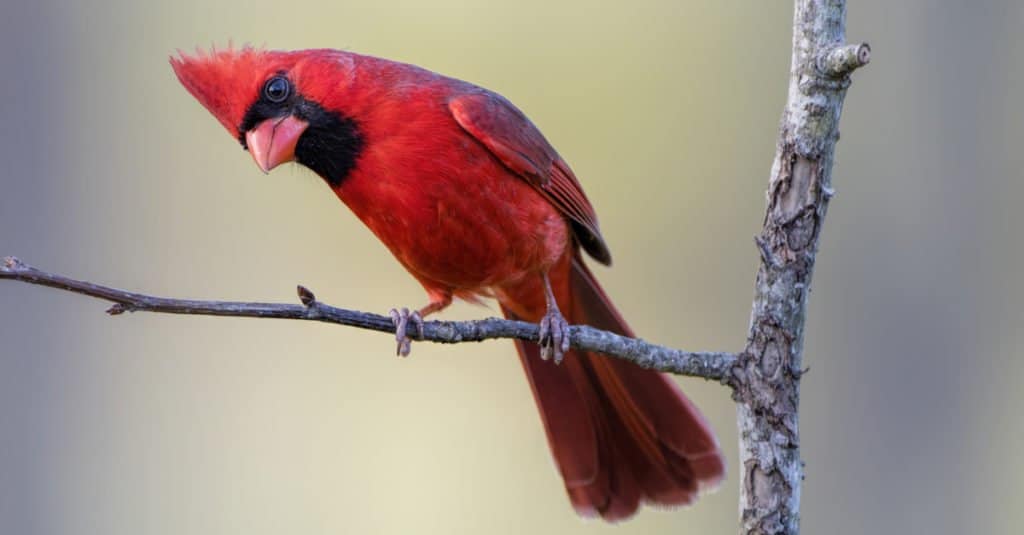
Bonnie Taylor Barry/Shutterstock.com
The northern cardinal goes by many other names including the redbird, common cardinal, or simply cardinal. Like the scarlet and summer tanager, it belongs to the cardinal family Cardinalidae. Of all the birds that are red, the northern cardinal is one of the most well-known. You can recognize males thanks to their bright red plumage, large crest, and black face mask. On the other hand, females look drabber, although they feature some red coloring on the tail, breast, and crest. Northern cardinals range throughout North America. That said, they mostly live in the eastern United States and Mexico and a small chunk of southeastern Canada. Their preferred habitats include woodlands, wetlands, scrubland, and urban areas. While they predominantly eat grain, northern cardinals also subsist on some berries and insects. While once threatened by the pet trade, it’s now protected, and the IUCN lists it as a species of Least Concern.
#1: ‘I’iwi
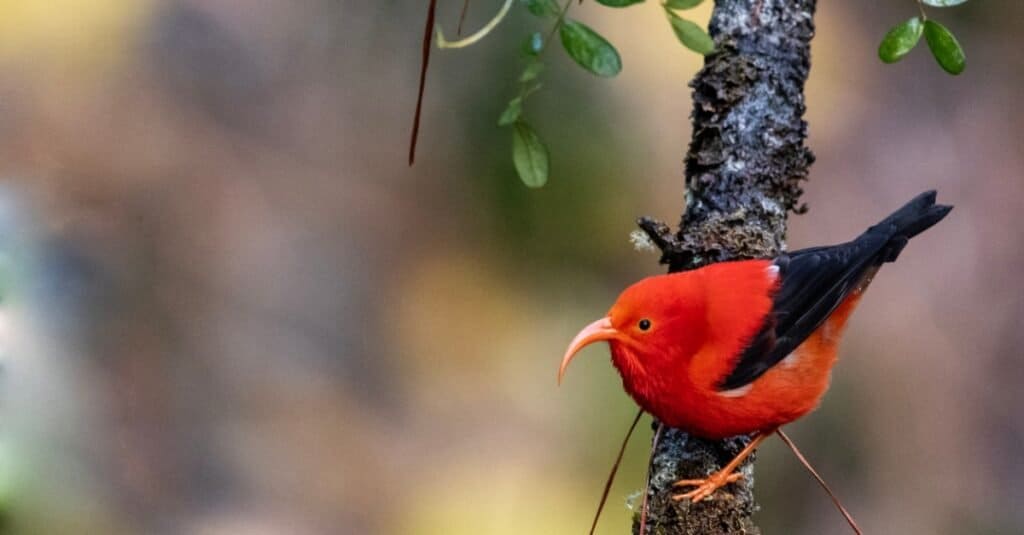
iStock.com/Mason Maron
The ‘I’iwi is the final entry in our list of birds that are red. Also known as the scarlet honeycreeper, it belongs to the finch family Fringillidae. It features bright scarlet feathers on its head, breast, and undersides, although its tail and wings look black. The ‘I’iwi uses its long, pink bill to drink nectar from flowers, which makes up most of its diet. That said, it also eats a wide variety of arthropods. ‘I’iwis live only in the Hawaiian Islands, where they rank as the third most abundant native bird species. They build cup nests made of twigs, flower petals, and feathers in the branches of trees. Currently, they face several threats due to habitat loss from farming and cultivation. Deforestation destroys both their homes and their sources of food. As a result, the IUCN lists the ‘I’iwi as a Vulnerable species.
More from A-Z Animals
Birds come in a wide variety of colors. Some feature relatively dull plumage, while others sport brightly colored feathers. Birds with bright feathers usually evolved specific colors in order to help them attract mates. Depending on the environment where they live, a bird’s coloration can also help camouflage them from predators. In addition, many birds get their color from foods in their diet. Of those birds that feature colorful plumage, there exists a number of birds that are red. These fiery birds stand out from even other eye-catching birds due to their strong, red colors. You can find red birds all over the world, although many fall into the songbird family of smaller birds. That said, some also classify as parrots or wading birds. In this article, we’ll discuss 10 different birds that are red. Hopefully, the next time you’re out and about, you’ll see one of these crimson-colored birds.
#10: Crimson Sunbird

iStock.com/chirawan
A member of the sunbird family Nectariniidae, the crimson sunbird totally deserves its name. Males of these species feature a bright crimson breast and back. Meanwhile, their belly appears light green and their tail is a burnt yellow color. Crimson sunbirds range throughout South and Southeast Asia and prefer to live in tropical forests. These tiny 4-inch long birds that are red build suspended nests on tree branches to house their eggs. Sunbirds primarily live off of nectar that they gather from flowers, and the crimson sunbird is no different. A fast flyer, the crimson sunbird often gets mistaken for a hummingbird due to its hovering abilities. In addition, it also eats a wide variety of insects. On occasion, sunbirds also go by the name spiderhunters due to their habit of hunting spiders. Due to its widespread distribution, the IUCN lists the crimson sunbird as a species of Least Concern.
#9: Scarlet Ibis

iStock.com/dabldy
The scarlet ibis is a member of the ibis family of birds Threskiornithidae. It stands apart from other ibises thanks to its bright scarlet coloration, which is where it gets its name. Virtually every part of its body is scarlet, from its head all the way to its toes. That said, their color includes a number of different shades that can range from light to dark. To find food, they use their long curved bills to dig in the mud, although they will also steal food from other animals. They get their red color from their diet of crab, shrimp, and other red shellfish. Scarlet ibises range throughout South America and the Caribbean and primarily live in wetland and coastal areas. Even outside of the breeding season, scarlet ibises live in large social groups. Currently, the IUCN lists the scarlet ibis as a species of Least Concern.
#8: Summer Tanager

Despite its name, the summer tanager is a songbird in the cardinal family Cardinalidae. Its name comes from its bright red color that covers its entire body and evokes associations of warm summer days. Although their color varies, male summer tanagers usually grow rose-red feathers, while the females appear yellowish-green. Their red color comes from their diet, which consists of a variety of berries and insects, especially bees. They range throughout the southern United States and Mexico in the summer and Central and South America in the winter. Typically, they live in woodland areas with plenty of trees where they can build their nests. Summer tanagers measure around 6.7 inches long and weigh about 1 ounce. If you encounter one outdoors, you may find that its vocalizations sound similar to an American robin’s. At this time, the IUCN lists the summer tanager as a species of Least Concern.
#7: Red-Billed Firefinch

Also known as the Senegal firefinch, the red-billed firefinch is another one of the birds that are red. The males feature dull scarlet feathers, although their wings appear more rufous or brown than red. Meanwhile, females appear more brown than red but do feature a red patch of feathers on their faces. However, both males and females feature a pink bill and yellow rings around their eyes. Red-billed firefinches belong to the Estrildidae family of finches and are endemic to Sub-Saharan Africa. They live in grasslands as well as cultivated areas and often live in close proximity to humans. Their diet primarily consists of seeds, but they will also dine on certain locally grown grains. Red-billed firefinches build a unique domed nest made of grasses in which they lay their eggs. Given their massive range and numbers, the IUCN lists them as a species of Least Concern.
#6: Scarlet Tanager

Stubblefield Photography/Shutterstock.com
The scarlet tanager is another member of the Cardinalidae family, the same as the summer tanager. It gets its name from the distinctive crimson or scarlet coloring that the males feature during the summer. While males appear predominantly red, their wing and tail feathers look black. On the other hand, the females appear yellowish-green year-round. Generally, scarlet tanagers measure 6.3 to 7.5 inches long and weigh around 1 ounce. They range throughout the eastern United States, Canada, and Mexico, and spend the winter in South America. Unlike other cardinals, the scarlet tanager sports a rather thin bill. This means it eats fewer seeds than other cardinals, preferring instead to hunt insects. They can catch insects in flight or on the ground, and eat a wide variety including bees, wasps, and spiders. For now, the IUCN lists the scarlet tanager as a species of Least Concern.
#5: Red Crossbill

iStock.com/bobloblaw
The red crossbill or common crossbill is a member of the finch family Fringillidae. Males feature either bright red or orange feathers, while females typically appear yellow or green. That said, they can alter considerably in the wild and contain an assortment of colors in their plumage. In addition, their wings appear more dark brown compared to the rest of their plumage. Meanwhile, the other half of its name, crossbill, refers to the shape of its beak. The red crossbill sports a bill where the top half overlaps the bottom half. This overlapping design allows the red crossbill to subsist on a diet of mostly hard conifer seeds and other fruits. Red crossbills primarily live in coniferous forests throughout North America, Europe, and Asia. Given its abundance and widespread distribution, the IUCN lists the red crossbill as a species of Least Concern.
#4: Vermilion Flycatcher

iStock.com/jsdeoliv
The vermilion flycatcher is a striking example among birds that are red. This tiny bird is a member of the tyrant flycatcher family Tyrannidae. The first half of its name, vermilion, refers to the bright vermillion-red color on the breast, belly, and crest of the males. Meanwhile, the second half of its name alludes to its habit of catching flies in midair. Aside from their red plumage, male vermilion flycatchers also feature brown tail and wing feathers. Most vermilion flycatchers measure between 5.1 to 5.5 inches long and weigh less than 0.5 ounces. They range throughout the southern United States, Mexico, and parts of South America. In addition to insects, their diet also includes a number of different grains. With a total population numbering in the millions, the IUCN lists the vermillion flycatcher as a species of Least Concern.
#3: Red-and-Green Macaw

Also known as the green-winged macaw, the red-and-green macaw is a large parrot in the family Psittaciformes. The red-and-green macaw gets its name from its plumage. Its chest, head, shoulders, and parts of its tail feathers all appear bright red. Meanwhile, it also features green and blue feathers on its wings. Red-and-green macaws range between 35 to 37 inches long and weigh from 2.3 to 3.7 pounds. Due to their distinctive appearance, they rank as one of the most recognizable birds that are red. You can find them in the wild throughout their native range in Brazil, Colombia, Bolivia, Ecuador, Peru, and Paraguay. Due to habitat loss and illegal trafficking activity, the wild population of red-and-green macaws is in decline. That said, given its abundance, the IUCN still lists the red-and-green macaw as a species of Least Concern.
#2: Northern Cardinal

Bonnie Taylor Barry/Shutterstock.com
The northern cardinal goes by many other names including the redbird, common cardinal, or simply cardinal. Like the scarlet and summer tanager, it belongs to the cardinal family Cardinalidae. Of all the birds that are red, the northern cardinal is one of the most well-known. You can recognize males thanks to their bright red plumage, large crest, and black face mask. On the other hand, females look drabber, although they feature some red coloring on the tail, breast, and crest. Northern cardinals range throughout North America. That said, they mostly live in the eastern United States and Mexico and a small chunk of southeastern Canada. Their preferred habitats include woodlands, wetlands, scrubland, and urban areas. While they predominantly eat grain, northern cardinals also subsist on some berries and insects. While once threatened by the pet trade, it’s now protected, and the IUCN lists it as a species of Least Concern.
#1: ‘I’iwi

iStock.com/Mason Maron
The ‘I’iwi is the final entry in our list of birds that are red. Also known as the scarlet honeycreeper, it belongs to the finch family Fringillidae. It features bright scarlet feathers on its head, breast, and undersides, although its tail and wings look black. The ‘I’iwi uses its long, pink bill to drink nectar from flowers, which makes up most of its diet. That said, it also eats a wide variety of arthropods. ‘I’iwis live only in the Hawaiian Islands, where they rank as the third most abundant native bird species. They build cup nests made of twigs, flower petals, and feathers in the branches of trees. Currently, they face several threats due to habitat loss from farming and cultivation. Deforestation destroys both their homes and their sources of food. As a result, the IUCN lists the ‘I’iwi as a Vulnerable species.






